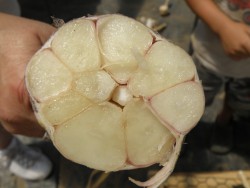Harvest Considerations for Garlic
Crystal Stewart-Courtens, Extension Vegetable Specialist
Eastern New York Commercial Horticulture

If leaves aren't the best indicator of maturity, how else can you tell? The best indicator is how the cloves are filling the wrapper leaves. Take a couple of average looking plants from each variety, and cut them in half perpendicular to the stem so that you are cutting through all of the cloves. Each clove should be tight in its wrapper leaves. If there is any give when you squeeze the bulb, or the wrapper leaves seem a little loose around the cloves the garlic will continue to expand for a little while longer (figure 1). A few of the outer wrapper leaves will probably be breaking down. That is normal.
You can also look at the shape of each clove. Cloves start out being more or less round, and expand to more of a wedge shape (figure 1). As garlic reaches full maturity, the cloves will pull very slightly away from the scape on hardneck varieties.
If you let the garlic stay in the ground too long, too many wrapper leaves will decay and the cloves will continue to expand until the garlic actually splits open. At this point the garlic becomes virtually unmarketable. Make sure that you check your garlic every few days, especially as we move into another warm stretch of weather.
As you are harvesting, keep in mind that you want to reduce the amount of water that you bring into your drying area and you want to avoid scalding your garlic during harvest. If you can harvest early in the morning (before 11 or so, depending on how hot the day is) on a dry day, then clean in the shade during the afternoon, you should have the best results possible. Allowing garlic to sit out in the field exposed to the sun can result in sun scalding, which will cause affected cloves to break down. If you have to harvest in wet weather try to remove as much mud as possible and to get any foliage you leave on the plant as dry as possible before moving it into the curing area. The higher the relative humidity is in your curing area, the slower the garlic will dry down. The slower the garlic dries, the more potential there is for disease. Dry garlic means lower relative humidity right from the start!

Upcoming Events
2026 Winter Cut Flower Webinar Series
January 6, 2026
The fifth annual CCE Cut Flower Webinar Series begins on January 6, 2026 and continues over 5 weeks on Tuesdays. This is a very popular series of online events you won't want to miss, with topflight speakers, a wide variety of subjects concerning growing cut flowers and plenty of interaction between speakers and attendees.
Tuesdays 1pm-3pm January 6, 2026 - February 3, 2026 (The webinar held on February 3 will run 1pm-4pm)
Cost: $60.00 for all five sessions, $20 for single sessions
Webinars will be recorded, and all the recordings will be sent to registrants for future review.
Expanding Farm Sales: Markets, Profits, and Branding Series
January 10, 2026
Looking to diversify where you sell your farm products? This four-part workshop series helps farmers explore new opportunities in direct-to-consumer, wholesale, and institutional markets. Learn how to meet buyer expectations, price for profitability, and build lasting relationships that support your business goals. Participants will strengthen marketing and communication skills, evaluate which sales channels best fit their farm, and connect with buyers, distributors, and local partners who can help expand their reach. Whether you're just starting out or ready to grow your market presence, this program will help you chart the right path for your farm's future.
Four Session Series: Saturdays from 10AM to Noon, January 10-January 31, 2026
Attend at one of three locations: Schoharie Extension Center - Cobleskill, NY; Otsego Education Center - Cooperstown, NY; Via Zoom
Pre-registration is requested! Fee: $25 Register Here
Any questions can be directed to Kelley Doolin at kmd322@cornell.edu
Pesticide Applicator Certification Exam Prep Course
January 13 - January 14, 2026
Join ENYCHP specialists for an in-depth review of topics covered on the NYS DEC pesticide applicator certification exam. This two-day virtual course includes explanation of key concepts on the core exam, test-taking tips for the core and category exam, practice questions, and Q&A with instructors. Course materials, including program recordings, practice exams, and DEC materials will be available to registrants after the program. This training is geared toward certification categories 1A (agricultural plant), 21 (field and forage), 22 (fruit), and 23 (vegetable).












































